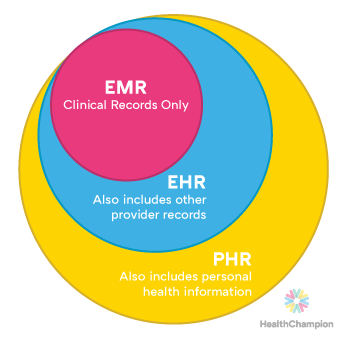What You Need to Know about Health Records, Personal Health Record
Health Records, Personal Health Record (PHR) may be a collection of health-related information that’s documented and maintained by the individual concerned. The data stored within Personal Health Record varies from person to person and from system to system. Here, the information during a typical record might include:
Information about Health Records, Personal Health Record:
- Allergy
- Case history
- Immunization
- Information about any condition or disease
- List of medicine taken
- Hospitalization records
- Information about the operation or procedure performed
How The Term Health Records, Personal Health Record has Evolved?
Health Records, Personal Health Record has been around since the 1990s. It wasn’t until 2007 that major technology companies. Like Microsoft and Google, began creating and offering PHR products, consistent with the American Health Lawyers Association. Google PHR products are not any longer available.
This was followed by the creation of Dossia, a web-based framework for PHR, in 2008 by a consortium of companies including Walmart and AT&T.
There are some debate about what constitutes PHR. Ultimately, this boils right down to a stand-alone PHR versus a tethered PHR.
With Health Records, Personal Health Record, patients enter information into their own records. Therefore, the information is stored on the patient’s computer or the web. Patients can decide whether to share their information. They are like care providers, relations, or anyone else involved.
In some cases, a stand-alone PHR can also receive data from external sources, like a laboratory or provider. However, within the end, the knowledge within the PHR is managed by the individual. Many consider this to be true PHR.
On the opposite hand, a tethered PHR is tied to an exact healthcare organization’s electronic health record (EHR) system. It means, patients can access their records within the tethered PHR via a secure portal. Many believe that a tethered PHR and a patient portal are an equivalent thing and, therefore, a tethered PHR isn’t really a PHR.
Benefits of Health Records, Personal Health Record
Increased Patient Engagement
Having the knowledge and tools to manage health and therefore the ability to trace health over time helps engage patients in their own health care. Furthermore, much of what patients do for his or her health takes place outside the four walls of the physician’s office. PHRs allow patients to document these events.
Better Access to Patient Information
In an emergency or when a patient is traveling, Health Records, Personal Health Record helps ensure their health information is out there whenever they have it.
Improved Management of Data from Multiple Providers
PHR helps patients manage information from multiple providers and may help improve coordination of care.
Reduced Administrative Costs
PHR reduces the burden on healthcare organizations so staff will spend less time checking out information that patients request and responding to patient questions.
Better Patient Provider Communication
PHR can improve communication between patients and doctors by providing an immediate and secure method of communication.
Ability To Manage Family Health Care
PHR can help caregivers, including relations, better manage patient care and help coordinate with other caregivers.
Barriers to Health Records, Personal Health Record
Despite the potential benefits, there are variety of challenges that PHR faces. They are such as privacy and security concerns to lack of use and adoption.
Data Accuracy
Concerns about data accuracy arise when patients or consumers log in and update their own health records. Sometimes, users got to be told and guided on the way to abstract relevant information from prescription labels and test reports, for instance.
Data Privacy and Security
There are less stringent data protection requirements for PHR. Vendors which provide stand-alone PHRs aren’t covered by the insurance Portability and Accountability Act (HIPAA). It is because they’re not protected entities like hospitals. Only PHRs tethered to a health care organization’s EHR are covered.
The Issue of Differences and Adoption Rates
A study published within the Journal of Medical Internet Research estimated that 75% of consumers are expected to possess adopted PHR by 2020. The digital divide has been created because of consumers having low computer competence and health literacy. Consumers with low literacy levels tend to not use PHR.
Health Records, Personal Health Record Software
There are several PHR options out there for patients to use. Here are some samples of the available options:
Dossia
Backed by companies like Walmart, Intel, et al., Dossia provides unbound PHRs extracted from multiple data sources and allows patients to take care of their PHRs whether or not patients change health plans, doctors, or employers.
HealthVault
Microsoft PHR enables the organization of loved one health data, preparation for doctor appointments and unforeseen emergencies, and comprehensive examination of patient health.
Health Manager
WebMD offers a PHR that permits patients to stay personal and family health records.
MyPHR
This PHR from the American Health Information Management Association (AHIMA) offers medical history storage for the elderly, seniors, chronically ill, and caregivers.
